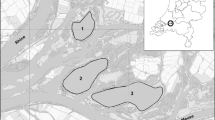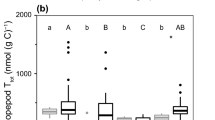Abstract
The amount of copper taken up via algae and water byMacoma balthica from the Oosterschelde sea arm, S.W. Netherlands, was established using the radioisotope64Cu. As far as we know, this isotope has never been used before in marine flod chain studies. As a model food source the marine diatomPhaeodactylum tricornutum was allowed to accumulate64Cu for 1 d. These labelled algae were fed to the clams in the presence of the complexing agent EDTA (0.27mM). EDTA was added to prevent uptake of dissolved64Cu that could be leaking from the labelled diatoms. In control experiments, unlabelled diatoms were fed toM. balthica in the presence of dissolved64Cu (with and without EDTA) in order to assure a similar filtration activity. In repeated experiments with varying particulate/dissolved copper ratios, uptake through food always turned out to be at least as efficient as uptake from the water. It was concluded that Cu, associated with food, is well available for uptake byM. balthica.
Similar content being viewed by others
References
Absil, M. C. P., Kroon, J. J., Wolterbeek, H. T. (1994). Availability of copper from phytoplankton and water for the bivalveMacoma balthica. I. Separation of uptake pathways using the radiotracer64Cu. Mar. Biol. 118:123–127
Amiard-Triquet, C., Amiard, J. C., Berthet, B., Metayer, C. (1988). Field and experimental study of the bioaccumulation of some trace metals in a coastal food chain: seston, oyster (Crassostrea gigas), drill (Ocenebra erinacea). Wat. Sci. Technol. 20:13–21
Baeyens, W., Gillain, G., Decadt, G., Elskens, I. (1987). Trace metals in the eastern part of the North Sea. I. Analyses and short term distributions. Oceanol. Acta 10:169–179
Borchardt, T. (1983). Influence of food quantity on the kinetics of cadmium uptake and loss via food and seawater inMytilus edulis. Mar. Biol. 76:67–76
Brafield, A. E., Newell, G. E. (1961). The behaviour ofMacoma balthica (L.) J. mar. biol. Ass. U.K., 41:81–87
Bricelj, V. M., Bass, A. E., Lopez, G. R. (1984) Absorption and gut passage time of microalgae in suspension feeder: evaluation of the31Cr:14C twin tracer technique. Mar. Ecol. Prog. Ser. 17: 57–63
Bryan, G. W. (1985). Bioavailability and effects of heavy metals in marine deposits. In: Ketchum, B. H., Capuzzo, J. M., Burt, W. V., Duedall, I. W., Park, P. K., Kester, D. R. (eds.) Wastes in the ocean, Vol 6. Nearshore waste disposal. Wiley-Interscience, New York, p. 41–77
Calow, P. (1975). Defaecation strategies of two freshwater gastropods,Ancylus fluviatilis Müll, andPlamorbis contortus Linn. (Pulmonata) with a comparison of field and laboratory estimates of food absorption rate. Oecologia 20:51–63
Decho, A. W., Luoma, S. N. (1991). Time-courses in the retention of food material in the bivalvesPotamocorbula amurensis andMacoma balthica: significance to the absorption of carbon and chromium. Mar. Ecol. Prog. Ser. 78:303–314
Eide, I., Jensen, A. (1979). Application of in situ cage cultures of phytoplankton for monitoring heavy metal pollution in two Norwegian fjords. J. exp. mar. Biol. Ecol. 37:271–286
Gilbert, M. A. (1977). The behaviour and functional morphology of deposit feeding inMacoma balthica (Linne, 1758), in New England. J. mollusc. Stud. 43:18–27
Golimowski, J., Merks, A. G. A., Valenta, P. (1990). Trends in heavy metal levels in the dissolved and particulate phase in the dutch Rhine-Meuse (Maas) delta. Sci. total Envir. 92:113–127
Harvey, R. W., Luoma, S. N. (1985). Separation of solute and particulate vectors of heavy metal uptake in controlled suspension-feeding experiments withMacoma balthica. Hydrobiologia 121:97–102
Hughes, R. N. (1969). A study of feeding in Scrobicularia plana. J. mar. biol. Ass. U. K. 49:805–823
Hummel, H. (1985). Food intake ofMacoma balthica (Mollusca) in relation to seasonal changes in its potential food on tidal mudflat in the Dutch Wadden Sea. Neth. J. Sea Res. 19:52–76
Janssen, H. H., Scholz, N. (1979) Uptake and cellular distribution of cadmium inMytilus edulis. Mar. Biol. 55:133–141
Levinton, J. S. (1989). Deposit feeding and coastal oceanography. In: Lopez, G., Taghon, G., Levinton, J. (eds.) Ecology of marine deposit feeders. Lecture notes on coastal and estuarine studies edn., Vol 31. Springer-Verlag, New York, p. 1–23
Luoma, S. N. (1983) Bioavailability of trace metals to aquatic organisms — a review. Sci. total Envir. 28:1–22
Luoma, S. N., Bryan, G. W. (1982). A statistical study of environmental factors controlling concentrations of heavy metals in the burrowing bivalveScrobicularia plana and the polychaeteNereis diversicolor. Estuar. cstl Shelf Sci. 15:95–108
Luoma, S. N., Johns, C., Fisher, N. S., Steinberg, N. A., Oremland, R. S., Reinfelder, J. R. (1992). Determination of selenium bioavailability to a benthic bivalve from partcculate and solute pathways. Envir. Sci. Technol. 26:485–491
Martincic, D., Nürnberg, H. W., Branica, M. (1987). Bioccumulation of metals by bivalves from the Limsky Canal (North Adriatic Sea) 3. Copper distribution betweenMytilus galloprovincialis and ambient water. Sci. total Envir. 60:121–142
Morton, B. (1973). A new theory of feeding and digestion in the filter-feeding lamellibranchia. Malacologia 14:63–79
Riisgård, H. U., Bjørnestad, E., Møhlenberg, F. (1987) Accumulation of cadmium in the musselMytilus edulis: kinetics and importance of uptake via food and sea water. Mar. Biol. 96: 349–353
Schulz-Baldes, M. (1974). Lead uptake from sea water and food, and lead loss in the common musselMytilus edulis. Mar. Biol. 25:177–193
Taghon, G. L., Self, R. F. L., Jumars, P. A. (1978). Predicting particle selection by deposit feeders: a model and its implications. Limnol. Oceanogr. 23(4):752–759
Valenta, P., Duursma, E. K., Merks, A. G. A., Rützel, H., Nürnberg, H. W. (1986). Distribution of Cd, Pb, and Cu between the dissolved and particulate phase in the eastern Scheldt and western Scheldt estuary. Sci. total Envir. 53:41–76
Wikfors, G. H., Ukeles, R. (1982). Growth and adaptation of estuarine unicellular algae in media with excess copper, cadmium or zinc, and effects of metal-contaminated algal food onCrassostrea virginica larvae. Mar. Ecol. Prog. Ser. 7:191–206
Zhang, G. H., Hu, M. H., Huang, Y. P., Harrison, P. J. (1990). Se uptake and accumulation in marine phytoplankton and transfer of Se to the clam Puditapes philippnarum. Mar. envirl Res. 30: 179–190
Author information
Authors and Affiliations
Additional information
Communication number 645 of the Centre for Estuarine and Coastal Ecology, Yerseke, The Netherlands
Communicated by O. Kinne, Oldendorf/Luhe
Rights and permissions
About this article
Cite this article
Absil, M.C.P., Kroon, J.J. & Wolterbeek, H.T. Availability of copper from phytoplankton and water for the bivalveMacoma balthica. II. Uptake and elimination from64Cu-labelled diatoms and water. Mar. Biol. 118, 129–135 (1994). https://doi.org/10.1007/BF00699227
Received:
Accepted:
Issue Date:
DOI: https://doi.org/10.1007/BF00699227




